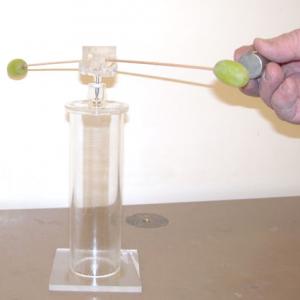College of Liberal Arts & Sciences
5G30.35 - Diamagnetic Grape
The most sensitive and best way to do this demo is to use the arm hanging from a thread assembly. Position the grapes on the ends of the assembly and move them in or out until you have achieved a balance where the grapes hang level. Use the large magnet to move the grapes around.
Using the rotating support is much more difficult as the system has to be in perfect balance which may take quite some time in some instances. Take two large grapes and mount them on the rotating support arm. You can move the grapes in and out to balance the support. When balanced you should be able to place the Neodymium magnet within a quarter of an inch to the grape and the grape should move away from the magnet. This shows the diamagnetic properties of liquid water.
An alternative is to fill one of the test tubes with water and balance it on the rotating arm. When the large magnet is brought near, the test tube should be repelled from the magnet.
- Tomasz Dindorf and Wojciech Dindorf, "A Useful Multipurpose Instrument", TPT, Vol. 40, # 7, p. 440, Oct. 2002.
- Daniel Laumann, "Is an Apple Magnetic: Magnetic Response of Everyday Materials Supporting Views About the Nature of Science", TPT, Vol. 55, #3, March 2017, p. 142-145.
- Andrey Geim, "Everyone's Magnetism", Physics Today, Sept. 1998, p. 36 - 39.
- "Letters: Tales of Bitter Magnetism", Physics Today 11, Dec. 1998.
- Don Rathjen, Paul Doherty, "Diamagnetic Repulsion", Square Wheels, 2002, p. 13.
- Jearl Walker, "5.48 Levitating Frogs", The Flying Circus of Physics Ed. 2, p. 240.
- "206, Levitating Mouse", Christopher P. Jargodzki and Franklin Potter, Mad About Physics , p. 77, 218.
- "Levitating Frogs", Popular Science, November 1997, p. 38.
Disclaimer: These demonstrations are provided only for illustrative use by persons affiliated with The University of Iowa and only under the direction of a trained instructor or physicist. The University of Iowa is not responsible for demonstrations performed by those using their own equipment or who choose to use this reference material for their own purpose. The demonstrations included here are within the public domain and can be found in materials contained in libraries, bookstores, and through electronic sources. Performing all or any portion of any of these demonstrations, with or without revisions not depicted here entails inherent risks. These risks include, without limitation, bodily injury (and possibly death), including risks to health that may be temporary or permanent and that may exacerbate a pre-existing medical condition; and property loss or damage. Anyone performing any part of these demonstrations, even with revisions, knowingly and voluntarily assumes all risks associated with them.
